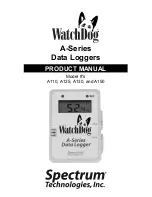
UM-155-290-Limpet User Manual
–
V2.0
7 |
P a g e
Select measurement unit:
Go to
‘Options’
then
‘Select Measurement Unit’
. Select either millimetres or inches.
Select calibration factor:
Go to
‘Options’
then
‘Select Calibration Factor’
. This is the precipitation multiplier and is known as
the ‘resolution’. It can be set to any value, bu
t it must be matched up with the appropriate rain gauge.
The resolutions EML tipping bucket rain gauges are shown in the table below:
Rain Gauge Model
Calibration Factor
Kalyx
0.2
SBS-314/0.2
0.2
SBS-314/0.5
0.5
SBS-500/0.2
0.2
SBS-1000
0.1
UPG-1000
0.1
Select memory mode:
Go to
‘Options’
then
‘Select Memory Mode’
. There are two options for configuring the logger’s
memory mode. These are described as follows:
Loop memory (overwrite oldest data):
This option means that the logger will continue indefinitely.
However, whenever the memory capacity is full, the oldest data will begin to be overwritten. A unique
feature of this logger is that if this happens, a record of the total rainfall including the ‘old data’ is kept,
even after the memory has been erased.
Stop when full:
This option stops the logger from recording any more data when the memory
becomes full.
6.
Event-based memory
The time of the contact closure (e.g. one tip of a tipping bucket rain gauge) is recorded to the nearest
second
. The logger ‘wakes up’ to record each rain gauge tip before returning to a sleep state. This
mode is ideal for precipitation intensity measurements, and is also the lowest power mode.
7.
Deploying the logger
The logger has now been configured. Now it must be connected to the rain gauge and made ready
for field deployment.
Disconnect the serial cable from the logger and replace the blue cap on the end of the connection
point. Any tips of the gauge that occur after this point will be recorded.






























